Bug Links
Pest & Bug Identification
Click a link on the right to display. Mouse over the image to enlarge.
Argentine Ant

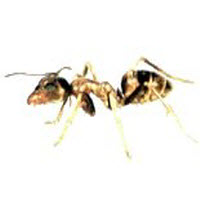
Argentine Ant
This species of ant is native to Argentina and Brazil and was probably introduced to the United States in freight ships around the 1890’s. These ants can be found in southern states and in California, Illinois, Maryland, Missouri, Oregon and Washington.
Diet
Argentine Ants prefer sweet substances but will eat almost anything including meats, eggs, oils and fats. Also, when foraging for food, Argentine ants leave pheromone trails everywhere they go, instead of just from nest to food source. This habit ensures they do not waste time visiting the same area twice. While in other ant species worker ants are primarily responsible for gather food, Argentine queens also assist with foraging for food.
Habitat
Argentine ant colonies are located in wet environments near a food source. These colonies can grow to monumental size, sometimes covering entire habitats, such as an entire garden or your whole back yard.
Impact
Argentine ants do not pose a health threat, but they can contaminate food by leaving their bodily waste behind.
Prevention
Eliminate standing water. Pests, such as ants, mosquitoes and termites, are attracted to moisture. Keep tree branches and other plants cut back from the house. Sometimes pests use these branches to get into your home. Make sure that there are no cracks or little openings around the bottom of your house. Sometimes pests use these to get into your home. Make sure that firewood and building materials are not stored next to your home. Pests like to build nests in stacks of wood.
Carpenter Ant


Carpenter Ant
Carpenter Ants get their name because they build their nests in wood. That can cause significant damage to the wood in your house. There are nine types of carpenter ants throughout the U.S. and range in size from one-quarter inch (about the width of a pencil) for a worker carpenter ant to three-quarters of an inch (about the size of a quarter) for a queen carpenter ant. Each colony is established by a single, fertilized queen. She starts her nest in a cavity in wood, where she raises her first brood of workers. She feeds them saliva and does not leave the nest or feed herself during this time. When they are ready, those workers then get the job of gathering food to feed the next generation. Once mature, this first generation of worker ants work to increase the food supply for the colony. The colony population grows very rapidly. A colony can eventually produce 2,000 or more workers.
Diet
Carpenter ants do not eat the wood they remove during their nest-building activities, but deposit it outside entrances to the colony in small piles. The diet of carpenter ants includes living and dead insects, meat, fats and sugary foods of all kinds, including honeydew and nectar from plants.
Habitat
Carpenter ants build nests anywhere they can find water and moldy or damp wood, such as tree stumps, firewood or in the plants around your house. Carpenter ants also build nests inside, usually entering buildings through wet, damaged wood, although it isn’t uncommon for them to adapt to drier environments.
Impact
Carpenter ants don’t carry disease, but when building a nest inside a home, Carpenter Ants dig smooth tunnels inside the wood. These tunnels weaken the wood and potentially damage the wood that keeps the house standing. This kind of damage can be very expensive to fix.
Prevention
Eliminate standing water. Pests, such as ants, mosquitoes and termites, are attracted to moisture. Keep tree branches and other plants cut back from the house. Sometimes pests use these branches to get into your home. Make sure that there are no cracks or little openings around the bottom of your house. Sometimes pests use these to get into your home. Make sure that firewood and building materials are not stored next to your home. Pests like to build nests in stacks of wood.
Red Imported Fire Ant

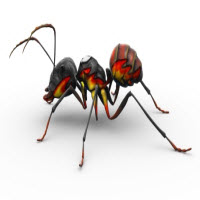
Red Imported Fire Ant
Red Imported Fire Ants are more aggressive than other ant species and have a painful sting. These ants and their telltale mound nests should be actively avoided. Red Imported Fire Ants can adapt to many climates and conditions in and around their environment. For example, if the colony senses increased water levels in their nests, they will come together and form a huge ball or raft that is able to float on the water!
Diet
They primarily feed on vegetation.
Habitat
Red imported fire ants will build their nests in mounds of soil outdoors, in landscape areas or near a building’s foundation. They occasionally enter buildings through holes or cracks in walls and foundations.
Impact
The sting of a Red Imported Fire Ant is painful and often results in a raised welt that becomes a white blister. Persons allergic to insect stings will react more severely. They are frustrating, not only because of the physical pain they can inflict, but because their mound-building activity can damage plant roots and lead to loss of crops.
Prevention
Eliminate standing water. Pests, such as ants, mosquitoes and termites, are attracted to moisture. Keep tree branches and other plants cut back from the house. Sometimes pests use these branches to get into your home. Make sure that there are no cracks or little openings around the bottom of your house. Sometimes pests use these to get into your home. Make sure that firewood and building materials are not stored next to your home. Pests like to build nests in stacks of wood.
Bed Bugs

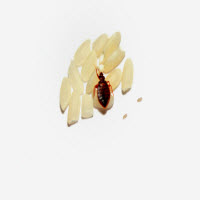
Bed Bug on rice
Bed bugs get their name because they are commonly found in beds but can also be found in other places where humans spend a lot of time: hotels, airplanes, and couches.
DIET
Bed bugs can feed on the blood of any warm-blooded animal. Their most common targets are humans because, unlike animals with fur, we have a lot of exposed skin for them to bite.
HABITAT
Bed Bugs are typically found in beds and small cracks and crevices.
IMPACT
When Bed bugs feed, they inject the skin with their saliva (this keeps the blood from clotting) and an anesthetic (this keeps the host from feeling the bite and moving). Bed bugs do not spread disease, but their bites can become red, itchy welts.
PREVENTION
Don’t take mattresses or padded furniture that has been left at the curb or on the street. Have someone check your scalp at least once a month to make sure you have not been exposed. Check your bed sheets for blood spots. Keep your suitcases covered in plastic and off the floor when you travel. When you travel, take a small flashlight to help you look for bed bugs. Bed bugs are hard to see, so if you think you have bed bugs, call a pest management professional.
American Cockroach

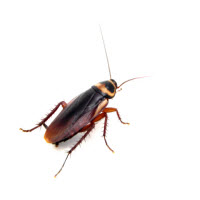
American Cockroach
The American cockroach is the largest cockroach found in houses. Females can hatch up to 150 offspring per year. Cockroaches don’t get their wings until the become adults.
DIET
American cockroaches will eat just about anything, including plants and other insects.
HABITAT
American cockroaches live in warm, dark, wet places, because they need to be near water. They are often found in sewers and basements, around pipes and drains.
IMPACT
Cockroaches crawl through dirty areas and then walk around our homes tracking in lots of bacteria and germs. They can contaminate food by shedding their skins. Their cast off skin and waste byproducts are allergens that can trigger allergic reactions, asthma and other illnesses, especially in children.
PREVENTION
Keep cooking, eating and food storage areas clean and dry. If you see cockroaches, it is best to call a pest management professional due to the illnesses they can spread.
Mouse over the image to enlargeGerman Cockroach

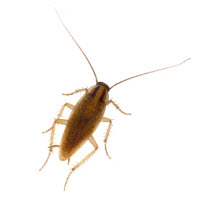
German Cockroach
German cockroaches can be found all over the world. They are the most common cockroach in the United States. Each German cockroach can live about 100-200 days.
DIET
Cockroaches are attracted to sweet and floury foods. They also eat non-organic items such as toothpaste and books!
HABITAT
German cockroaches live in warm and damp places, like kitchens, bathrooms, and places where people eat and drink.
IMPACT
Cockroaches crawl through dirty areas and then walk around our homes tracking in lots of bacteria and germs. They can contaminate food by shedding their skins. Their cast off skin and waste byproducts are allergens that can trigger allergic reactions, asthma and other illnesses, especially in children.
PREVENTION
Keep cooking, eating and food storage areas clean and dry. If you see cockroaches, it is best to call a pest management professional due to the illnesses they can spread.
Earwigs

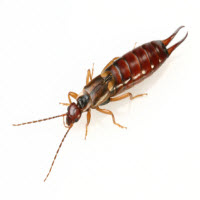
Earwigs
Earwigs get their name from the myth that they crawl into sleeping people's ears and tunnel into the brain. They do not really do that! There are 22 types of Earwigs in the United States and there are over a 1,000 different species all over the world.
Diet
Earwigs feed on leaves, flowers, fruits, mold and insects.
Habitat
Earwigs hide during the day and live outdoors in large numbers. They can be found under piles of lawn clippings, compost or in tree holes. They enter buildings through cracks in the walls.
Impact
They do not spread disease, but they can be scary to look at.
Prevention
Remove leaf piles, compost piles or other vegetation from around your home. Seal cracks and crevices in the walls of your house.
Mosquitoes
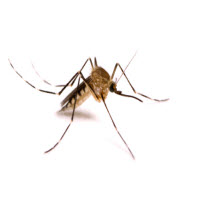

Mosquitoes
There are about 170 different kinds of mosquitoes in North America alone. These pests are part of the same family as houseflies and fruit flies, because they all have two clear, veined wings. Best known as a summer pest, Mosquitoes can develop from egg to adult in 10 to 14 days.
Diet
We usually say, "I have been bitten by a mosquito", but this is not completely true. Mosquitoes do not bite. Female mosquitoes feed on plant nectar and blood. They need the protein to reproduce. To get to the blood, they pierce our skin with their "proboscis" and suck our blood. Male mosquitoes feed exclusively on plant nectars. Mosquitoes are busiest at night and will fly up to 14 miles for a blood meal. They hunt for food by detecting body heat and Carbon Dioxide , the gas we breathe out.
Habitat
Mosquitoes breed in soft, moist soil or stagnant water sources such as storm drains, old tires, children's wading pools and birdbaths.
Impact
Mosquitoes spread diseases such as West Nile Virus, malaria and dengue fever.
Prevention
Replace all stagnant water at least once a week. Remove trash from around any standing water. When sleeping outdoors or in areas where mosquito populations are heavy, surround your bed with "mosquito" netting. Screen windows, doors and other openings with fine mesh. Avoid going outdoors at night. Use insect repellent containing DEET on exposed skin anytime you’re around mosquitoes. DEET doesn’t kill the mosquitoes. It just disorients them and they look elsewhere for food.
Drywood Termites

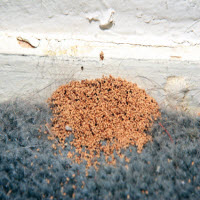
Drywood Termite pellets
Drywood termites form colonies of up to 2,500 members. Drywood Termite colonies don’t have workers. Younger termites, called "false workers", do all the work for the colony.
Diet
Drywood Termites eat wood, wallpaper, plastics and fabric made from plants.
Habitat
Drywood Termite colonies are usually found in dry wood and they do not require moisture or contact with the soil.
Impact
Drywood termites can build nests and dig tunnels in buildings. These tunnels cause major damage because the wooden support beams can become weak and make the building lean or fall down.
Prevention
Make sure firewood and scrap wood is stored away from your house. Seal all cracks and crevices around the outside of your home.
Subterranean Termites


Subterranean Termite tubes
Subterranean Termite colonies can have up to 2 million members! Their colonies are divided into three groups: workers, soldiers and reproductives.
Diet
Termites eat wood, wallpaper, plastics and fabric made from plants.Habitat
Subterranean termites need contact with the soil to survive. They live in underground colonies or in wet areas aboveground. They build tunnels to reach food and every spring, groups of reproductive termites fly off to start new colonies.Impact
Subterranean termites are the most destructive kind of termite. They can eat a lot of wood and they can cause a lot of expensive damage to a house! They can destroy building foundations, wooden support beams, plastic plumbing pipes, sub-flooring, insulation … even swimming pool liners and filtration systems! Termites can also injure or destroy living trees and shrubs.Prevention
Don’t let water pool around your home's foundation. Termites like that! Never leave wood scraps in the yard for them to snack on.
Black and Brown Widows

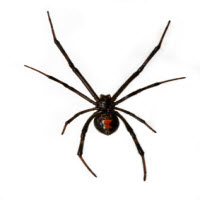
Black and Brown Widows
Female Black Widow spiders have a red hourglass shape on their backs. Males have white spots on their sides. Males only live about a year, but the female can live up to 3 years. Hungry female Black Widow spiders have been known to kill the male spider after mating, but that isn’t always the case. Geographically, Black Widow spiders can be found in the Eastern, Central and Western United States. Brown widow spiders are prevalent in the south.
Diet
Black Widow spiders eat other pests. Sometimes they even eat other spiders!
Habitat
Black Widow spiders tend to live in cellars and in piles of wood or trash.
Impact
The bite of a female Black Widow spider can be poisonous but not deadly to humans. The male Black Widow spider does not bite. A Black Widow spider bite is pale in the middle with a red ring around it and is followed by severe cramping, weakness, sweating, headache, anxiety, itching, nausea, vomiting, difficult breathing and increased blood pressure.
PREVENTION
Wear heavy gloves when moving things that have been stored for a long time. Shake out your shoes before putting them on. Just to be safe, stay away from spider webs.
Roof Rat

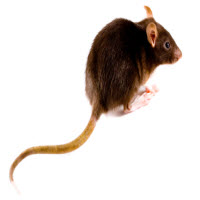
Roof Rat
Roof Rats are excellent climbers and get their name because they usually live high off the ground, like on the roof of a building. They have very poor vision and are color blind, but they have extremely strong senses of hearing, smell, touch and taste. Rats have four to six litters a year and each litter has 6 to 12 babies in it. These rats are only pregnant for about 21 to 23 days and they can start reproducing when they are three months old.
Diet
Roof Rats prefer eating fruits, berries, vegetables, cereal, pet food, nuts, grain, slugs, snails and rotten food.Habitat
Roof Rats are excellent climbers and they usually live in spaces on the tops of buildings, on roofs or in attics. They also live in sheds, garages, boxes, ceilings, under floors, in wood heaps and in thick grass.Impact
Roof rats cause damage to structures by chewing, eating stored foods and carrying diseases, such as Hantavirus. They are most famous for spreading the highly contagious bubonic plague in the Middle Ages. Rats will also attack both animals and humans. Human babies and even adults have been killed in rat attacks.Prevention
Rats like to eat, so keep your homes clean and do not leave food out. Make sure that your home and storage areas are clean and dry. Make sure that you clean your sheds, crawlspaces, and garbage cans often. Close up any small holes and cracks they can come in through.
